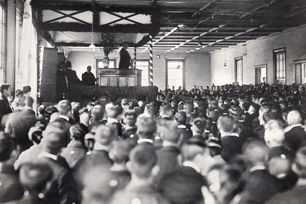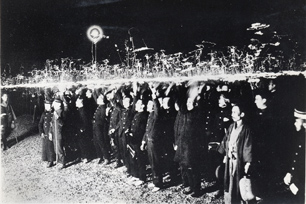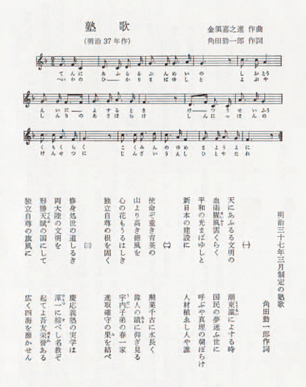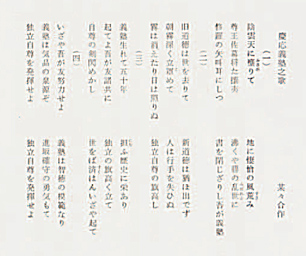The Time-honored Tradition of Keio School Songs: The events surrounding the 1904 establishment of the first Keio School Song
The Keio School Song has a strange power. Every time we join our voices to sing it, we feel the joy and pride of belonging to Keio. But even before this song was established, there was in fact an old school song which is said to be a forerunner of school songs in Japan.
The Momentum Builds for an Official School Song, Leading up to the 50th Anniversary of the Founding of Keio Gijuku

In the years just before the 50th Anniversary, voices began being heard asking for an official school song.
"See, our flag is waving in the wind." So starts Keio Univeristy's school song, which was made the official song on 12 November 1940 and first presented on 10 January of the next year on the Anniversary of Yukichi Fukuzawa’s Birthday. The lyrics were written by Masafumi Tomita, a staff member at Keio and a noted historian of Fukuzawa-sensei, and the music was composed by Kiyoshi Nobutoki, a professor at the Tokyo Music School (later renamed to the Faculty of Music, Tokyo University of the Arts).
Since then, the song has been sung for over 70 years at Keio ceremonies and events, but this is actually not the first school song for Keio University. The first school song was established over 110 years ago in March of 1904 and is now known as "the old school song." The lyrics were written by Keio graduate, Kinichiro Kakuda, who was working as a newspaper reporter, and the music was composed by Yoshinoshin Kisu who was quite active as a conductor and composer.
In the years leading up the 50th Anniversary of the Founding of Keio Gijuku which was planned for 1907, there were increased calls for a school song that expresses the true spirit of Keio. In one such example, at an afterparty following a graduation ceremony on 3 March 1900, lecturer Masayoshi Takagi declared that “…if Keio University aims to thrive, it is imperative that we create a school song with the power to inspire people, and it should be sung in chorus at gatherings like this.”
Also, the first Waseda-Keio Baseball Game was held in 1903 with Keio taking the victory. There are no records as to whether the Waseda-Keio rivalry helped to inspire the formalization of a school song, but presumably there was increased momentum for a song to cheer on the school.
A School Song about "Independence and Self-Respect" and "Practical Learning": A Pioneer Among School Songs



Finally, in 1903, an open call was made out to all students and alumni for lyrics submissions for a new school song. However, of all the submissions, none satisfied President Eikichi Kamata or the former president and current shato* Tokujiro Obata, and that is when Kakuda was asked to write them.
Kakuda was a Keio University Alumni who was a successful literary critic and reporter, and he used to write literary reviews for the magazine Kokumin no Tomo ("Friends of the Nation" launched by Soho Tokutomi) under the pen name "Koko Kakyaku.” Besides the old school song, he also wrote the "Kandelaar March,"** leaving behind a legacy of songs for Keio Gijuku.
Kakuda finished the lyrics at the end of 1903 and Kisu—who gave lessons to the Keio Wagner Society Orchestra—arranged the music on time for the song to be formally established on March 5, 1904.
This old school song, about “Independence and Self-Respect” and “Practical Learning,” was presented earlier than both Waseda and Doshisha University's school songs, and served as a pioneer of school songs in Japan.
However, there was actually a Keio school song that preceded this one, referred to as the "old-old school song." One year before the old school song was established, an article concerning the "Song of Keio University" in the June 1903 edition (volume 28) of Mita Hyoron. Then, in October of the same year, an article in the Keio Gijuku Gakuho reveals that “the school song was sung in chorus” at a dormitory commemorative reception earlier that month, which probably refers to the same song. It is said that this song was penned by Seiichiro Takahashi, a student at the time, who went on to serve as a professor of the Faculty of Economics and contributed to rebuilding the university as Deputy President after current President Shinzo was injured in the Second World War.
Keio University has a long history of school songs, and over the last 100-plus years, students and alumni alike have continually reemphasized the importance of a school song that can be sung together in chorus.
* Shato at the time was the highest position of authority at Keio, above the rank of President.
**The Kandelaar March is a song for the Kandelaar Parade held by Keio University. "Kandelaar" is a Dutch word meaning "lamp" or "candlestick" and refers to a portable lantern which was a tin can with lamp oil in it. The Kandelaar Parade was an event unique to Keio University which was celebrated from the Meiji era until the early Showa era and became quite famous throughout Japan.
*Photographs used in the article are preserved by the Fukuzawa Memorial Center for Modern Japanese Studies.
